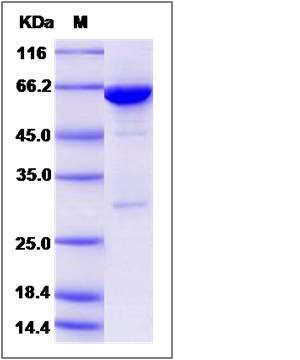Mouse PTPN6 Protein (aa 207-597, His & GST Tag)
70Z-SHP,hcp,Hcph,me,Ptp1C,PTPTY-42,SH-PTP1,SHP-1
- 100ug (NPP2780) Please inquiry
| Catalog Number | P50894-M20B |
|---|---|
| Organism Species | Mouse |
| Host | Baculovirus-Insect Cells |
| Synonyms | 70Z-SHP,hcp,Hcph,me,Ptp1C,PTPTY-42,SH-PTP1,SHP-1 |
| Molecular Weight | The recombinant mouse PTPN6/GST chimera consists of 628 amino acids and has a calculated molecular mass of 72.7 kDa. The recombinant protein migrates as an approximately 63 kDa band in SDS-PAGE under reducing conditions. |
| predicted N | Met |
| SDS-PAGE |  |
| Purity | > 85 % as determined by SDS-PAGE |
| Protein Construction | A DNA sequence encoding the mouse PTPN6 (P29351-2) (Ala207-Lys597) was fused with the N-terminal polyhistidine-tagged GST tag at the N-terminus. |
| Bio-activity | Measured by its ability to dephosphorylate a phosphotyrosine residue in an EGF receptor 988998 phosphopeptide substrate, R&D Systems, Catalog # ES006. The specific activity is > 4 μmoles/min/μg. |
| Research Area | Immunology |Signal Transduction |ITIM/ITAM Immunoreceptors and Related Molecules |
| Formulation | Lyophilized from sterile 20mM Tris, 500mM NaCl, pH 7.0, 10% glycerol 1. Normally 5 % - 8 % trehalose, mannitol and 0.01% Tween80 are added as protectants before lyophilization. Specific concentrations are included in the hardcopy of COA. |
| Background | PTPN6 is an enzyme which belongs to the protein tyrosine phosphatase (PTP) family. PTPs are signaling molecules that regulate a variety of cellular processes including cell growth, differentiation, mitotic cycle, and oncogenic transformation. N-terminal part of PTPN6 contains two tandem Src homolog (SH2) domains, which act as protein phospho-tyrosine binding domains, and mediate the interaction of PTPN6 with its substrates. PTPN6 is expressed primarily in hematopoietic cells, and functions as an important regulator of multiple signaling pathways in hematopoietic cells. It has been shown that PTPN6 interacts with, and dephosphorylate a wide spectrum of phospho-proteins involved in hematopoietic cell signaling. |
| Reference |
